Why Concrete Pavers Suck
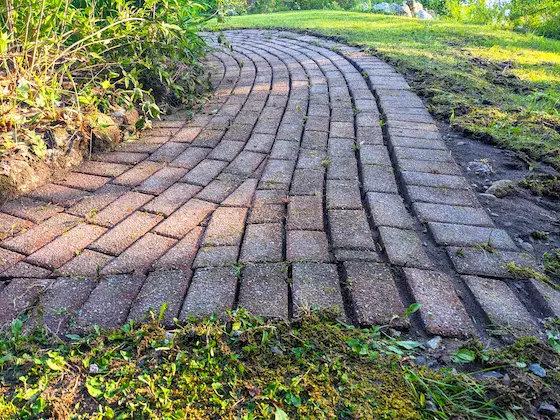
Why Concrete Pavers Suck | This is a sidewalk built using concrete paver brick. Hours before it was power washed to remove stubborn moss growth. It’s a hot mess. Copyright 2023 Tim Carter ALL RIGHTS RESERVED
Why Concrete Pavers Suck - There are So Many Reasons
It’s really important for businesses to introduce new products. Tens of thousands are introduced each year in the home improvement vertical. Once you’ve had enough trips around the sun, you can spot ones that have lots of sizzle but most likely won’t stand the test of time. I had that feeling forty years ago when I first saw colored concrete paving bricks become the belle of the ball.
It turns out my gut feeling was correct. The evidence is all around you that concrete paving brick can’t lace the boots of true clay paving brick. Here are just a few of the reasons.
You may own hundreds of concrete paving bricks or walk across them at a park or outdoor shopping mall. These bricks come in many different shapes, sizes, and colors. Several years ago my wife wanted an instant outdoor patio and I could only satisfy her desire by using large-format concrete patio stones that came in different sizes. They interlocked in a random Ashlar pattern.
The large pavers I used were made the same way as the concrete brick you may have. Concrete companies mix small stone chips, coarse sand, Portland cement, and dry pigments together with a precise amount of water. The mix is poured into molds to make the brick or larger pavers. They’re cured to gain maximum strength and the colors are rich when the products leave the manufacturing plant. The color you see is created by the ultra-thin pigmented cement paste covering the sand and gravel at the surface.
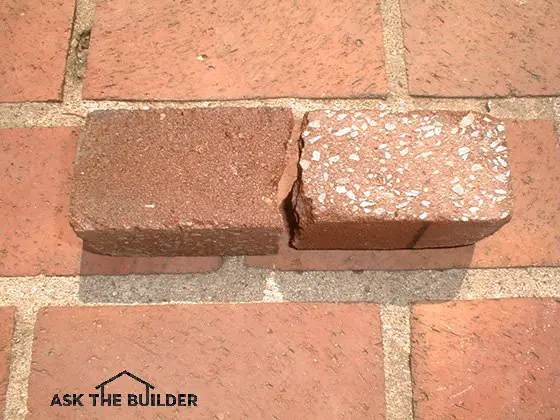
I cracked the new paving brick in half. Look at how light-colored the aggregate is! Over time when the red cement paste wears off, the pavers will look different. My traditional clay paving brick patio you see below the POC concrete paver will stay red forever because the red clay is the same color throughout the entire brick. © 2023 Tim Carter ALL RIGHTS RESERVED
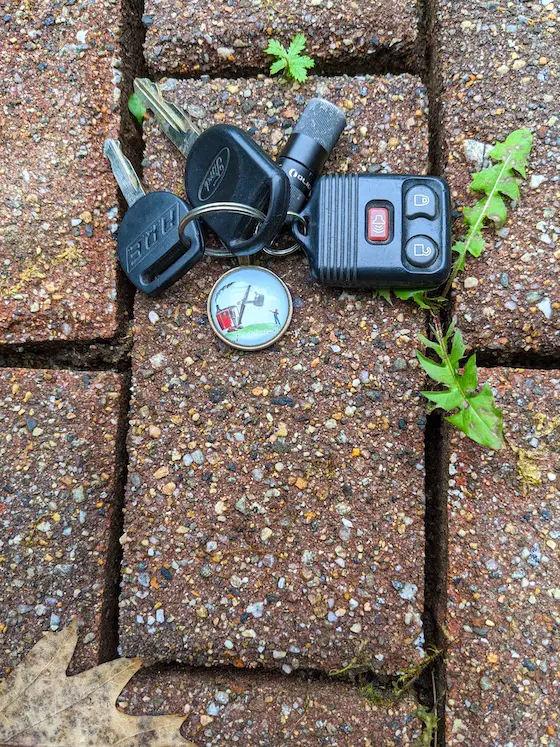
Here is a close-up shot of a concrete paver brick from my rear sidewalk. Look at the exposed aggregate and note all the different colors. When this brick was new, it had a uniform brown color and a smoother finish at the top. You can verify this by simply removing a brick or two from the sidewalk and turning them over to inspect the underside that has not been exposed to natural or man-made erosion. Twenty harsh New Hampshire winters coupled with no less than two power-washing cleanings show you why these bricks are no match for the solid color of true clay paving brick. Copyright 2023 Tim Carter ALL RIGHTS RESERVED
Use Clay Pavers Not Concrete
Real bricks are made from clay. The clay is cut into the final brick shapes and then fired in a huge kiln. The high-temperature firing process produces a chemical change in the clay creating an artificial rock of sorts. Some clay bricks can be fired so hard they are strong enough to be used as normal street paving. You can see this in the streets of downtown Athens, Ohio.
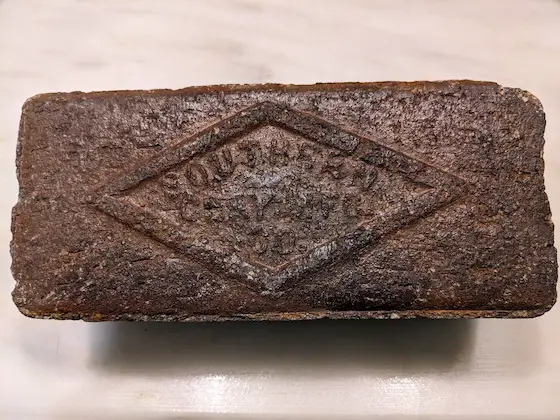
This is a real clay paving brick made by the Southern Clay Brick Company. It's 8 and 5/8ths inches long, 4 inches wide, and 3 inches thick. It was salvaged from the Old Brick Road in central Florida very close to the Bunnell-Palm Coast section of the road. Copyright 2023 Tim Carter ALL RIGHTS RESERVED
Clay paving brick doesn’t change color over time. Concrete paving brick fade and change color. That thin-colored cement paste wears off with normal wear and tear or you can blast it off using your power washer. After one or two cleanings, all of a sudden you see the color of the stone chips and sand.
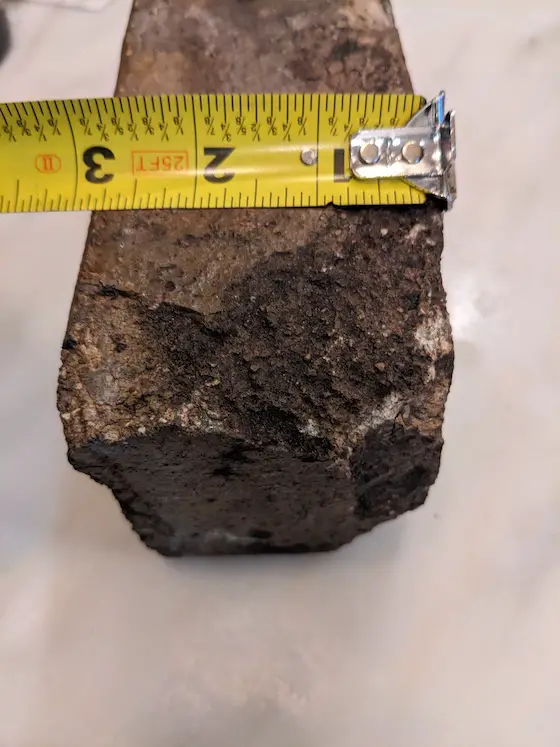
This is the same clay paving brick you see in the above photo. It has a chip on one corner. You can see the solid color of the clay throughout the brick. This brick will not change color over time. Copyright 2023 Tim Carter ALL RIGHTS RESERVED.
Set Bricks on Concrete Not Sand
Another issue with concrete paving bricks is the way they’re set. Almost all are set in a bed of sand. Burrowing animals can and do tunnel through the sand. The bricks can settle, tilt, and look horrible in short order. I know this because it’s happened here at my own home. Here's a video showing an animal burrow under a paving brick sidewalk.
I didn’t build the house I live in and I inherited two concrete paver brick walkways when I bought this home. One walkway looks better than the other, but both no longer are flat as they were the day they were installed.
Weeds and concrete paver bricks are like peanut butter and jelly. You can count on weeds growing up in between the bricks if you live where you get enough water to support the growth. A weed hacker can be used to trim the visible growth but days later the weeds sprout new green growth.
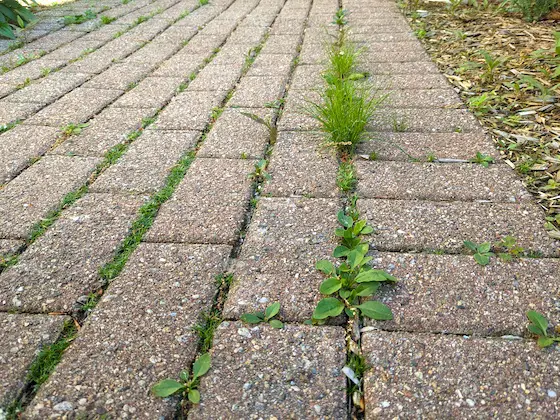
These are normal weeds growing in between the joints of concrete paving bricks. Look at how much aggregate in the concrete is now showing. The bricks look like they're 1000 years old but they've only been in use 20 years. Don't buy them. They SUCK. Copyright 2023 Tim Carter ALL RIGHTS RESERVED
Ants love concrete paving brick. They transport the sand under the brick up to the surface as they create comfy nests under the bricks. You can broom or blow the sand away with little effort, but it’s just another nuisance to deal with.
The gaps between concrete paving bricks are typically filled with fine sand. Some pavers have tiny bumps on the sides so a wider joint between each brick is created once installed. My large-format pavers had this.
Powerwashing RUINS Concrete Pavers
Manufacturers have known for decades that people love to clean their concrete pavers with a power washer. The issue is no matter how careful you are, the high-pressure stream digs out the sand.
The manufacturers responded by inventing polymeric sand. This is just sand that comes with a water-activated adhesive. When I first saw this product, I was skeptical. I simply couldn’t believe that a water-based adhesive could withstand Mother Nature. Once again, my gut instinct was spot on.
I used polymeric sand on the new patio pavers I used to make She Who Must Be Obeyed happy knowing that it was doomed to fail. I followed the instructions to the letter and the sand looked fantastic for two years. Then it slowly succumbed to the harsh New Hampshire winters. I have weeds growing on my patio, some of the sand is missing, and it all needs to be redone.
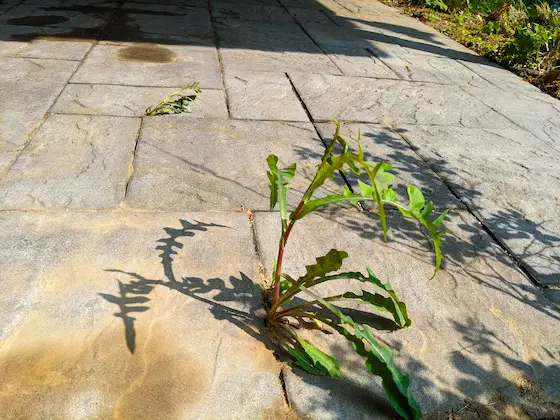
This is the concrete paver patio I built for my lovely wife. The joints between each paver is about 1/8-inch wide. They were filled with polymeric sand. Look at the weeds growing through the sand. It's POC just like concrete pavers.
If you want a trouble-free brick patio, my suggestion is to do what I’m starting to do at my son’s house. We’re installing thin split clay paving brick on a steel-reinforced concrete slab. The space in between each brick will be filled with mortar that will test out at 12,000 pounds per square inch. Soon you’ll read an upcoming column about this project and I’ll share detailed step-by-step videos of the process.
Column 1510
4 Responses to Why Concrete Pavers Suck